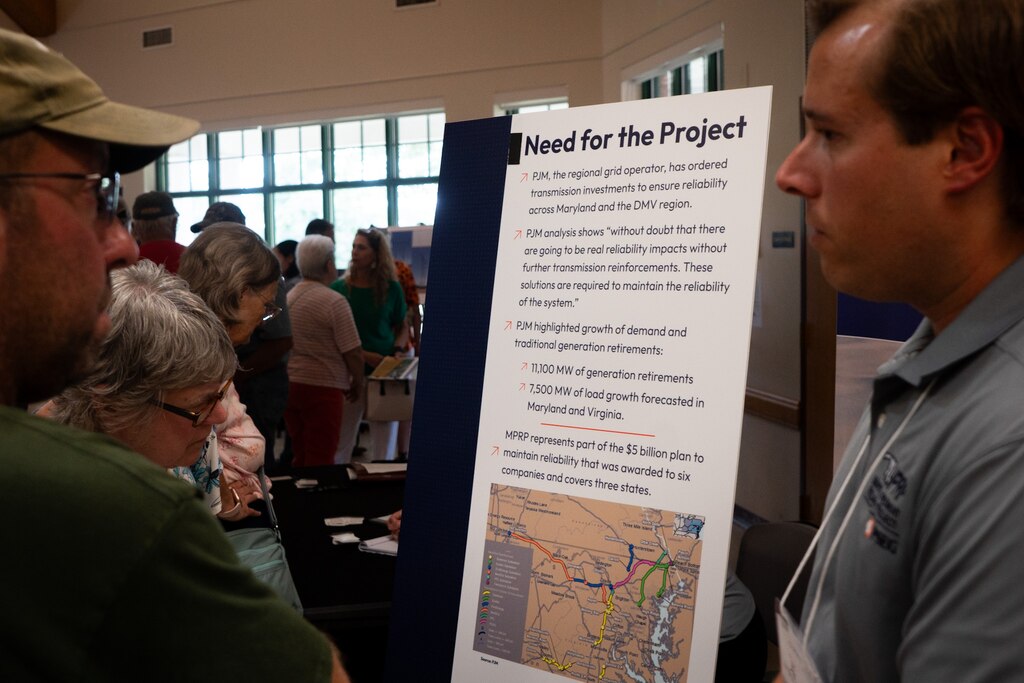A company selected to develop a controversial 70-mile power transmission line that would slice through Baltimore, Carroll and Frederick counties has announced a route for the project.
On Friday morning, the New Jersey-based Public Service Enterprise Group (PSEG) unveiled a route that it says would mitigate many of the concerns that residents have aired at packed public meetings around the area.
The company was chosen by PJM Interconnection, which manages the power grid for Maryland and several other states
On Tuesday, more than a dozen Baltimore County residents turned out at a County Council meeting to voice objections to the plans. Residents contend that the line would degrade the environment and hamper local farming.
Still, the proposed Maryland Piedmont Reliability Project, an electrical network that backers say would power large swaths of the state and other areas, appears to be inching forward.
With Friday’s announcement, here are some things to know about the project.
Where will the transmission lines run?
The project would snake through much of northern Maryland from the upper edge of Gunpowder Falls State Park in Baltimore County through small towns like New Windsor and past lush farmland near Frederick.
It would start north of Route 439 in northern Baltimore County, follow a westward path and then veer to the south in Carroll County. It would cross Interstate 83 west of Westminster, Route 28, Interstate 70 east of Frederick and Interstate 270 south of the city before terminating.

What is the purpose of the project?
The transmission lines would help Maryland and other areas meet demands for electricity, said Jason Kalwa, a project director for PSEG. They would provide power for regular utility use and data centers in Maryland and Virginia.
The project could lower utility rates for Maryland residents, Kalwa said. Marylanders have historically faced bloated utility bills, partly because of surging utility demand and local scarcity. Maryland imports 40% of its power from other states and is retiring its coal-fired power plants to in a statewide effort to reduce fossil fuel emissions.
What do local residents say about the project?
The project has stoked anger among local officials and residents who say the steel transmission lines could hurt property values and ease a pathway for utility companies to seize private land through eminent domain. PSEG has previously said that eminent domain is an unlikely last resort.
Marylanders also worry that they could end up financing hefty utility use in Virginia through the project. PSEG previously said the lines would power data centers in Maryland and Virginia, but Maryland doesn’t have any data centers yet and the only pending project, in Frederick County, is proceeding with utilities from another company.
This week, all seven members of the Baltimore County Council signaled support for a resolution opposing the project.
“You know going through preserved land is going to take away the potential to produce food for this area in the future,” said Councilman Wade Kach. “Baltimore County has some of the largest areas of prime productive soil.”
Earlier this year, Frederick County Executive Jessica Fitzwater and the Frederick County Council noted that the proposed transmission line could compromise the farmland and aqueducts they run through.
In July, Carroll County commissioners released a statement saying they would “leverage all [the board’s] influence with our neighboring jurisdictions as well as state and national leaders to halt the project in its current form.”

Does the new route address the concerns of local residents?
Of the 10 alternatives that PSEG has floated since July, the company chose a path that addressed many of the concerns expressed by more than 5,300 Marylanders who submitted comments, said Dawn Shilkoski, a project manager at PSEG.
The transmission line would have fewer hard turns than others, which helps to reduce the complexity and cost of the project. It has been rerouted around agricultural businesses and residences. And, Kalwa added, farmers can largely continue their operations underneath the transmission lines.
But the route doesn’t do much to ease environmental concerns, Shilkoski conceded. For example, the region by the transmission lines will face height limits for vegetation, plants and nursery stock. The developers could not provide information on how the route would affect the water supply in nearby Prettyboy Reservoir.
“Every route is going to have impacts,” Kalwa said. “We believe we minimized the impacts to the extent possible.”
When would construction start?
The project is still in its approval phase. PSEG plans to submit an application to the Maryland Public Service Commission by the end of the year or in early 2025. After that, the developers would face a series of public hearings before the commission, which signs off on high-powered transmission line construction. If the agency approves the project, PSEG would start construction in January 2026.
The company says on its website that it hopes to see the transmission lines operational by June 2027.
When and where are the next public hearings?
PSEG will hold public hearings in Frederick, Baltimore and Carroll counties in mid-November.
The Baltimore County hearing will be held on Tuesday, Nov. 12, 6-8:30 p.m. in the Embassy Suites by Hilton at 213 International Circle, Hunt Valley.
The Carroll County hearing will be held on Wednesday, Nov. 13, 6-8:30 p.m. in the Agricultural Center at 706 Agricultural Center Drive, Westminster.
The Frederick County hearing will be held on Thursday, Nov. 14, 6-8:30 p.m. in New Market District Volunteer Fire Company at 76 W. Main St., New Market.

Baltimore Banner reporter Rona Kobell contributed to this report.



Comments
Welcome to The Banner's subscriber-only commenting community. Please review our community guidelines.